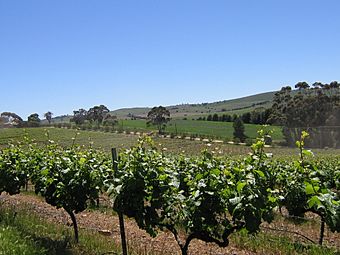Clare Valley wine region facts for kids
| Wine region | |

Vineyards in Clare Valley
|
|
| Type | Australian Geographical Indication |
|---|---|
| Year established | 1999 |
| Country | Australia |
| Part of | Mount Lofty Ranges zone |
| Sub-regions | Informal:
|
| Climate region | ’I’ |
| Heat units | 1770 |
| Precipitation (annual average) | 200 mm (7.9 in) |
| Size of planted vineyards | 5,339 ha (13,190 acres) |
| No. of vineyards | at least 200 growers |
| Grapes produced | 19,796 tonnes (19,483 long tons; 21,821 short tons) |
| Varietals produced | Shiraz, Cabernet Sauvignon, Riesling, Merlot |
| No. of wineries | at least 48 |
| Comments | 2012 & 2014 |
The Clare Valley wine region is one of Australia's oldest areas for making wine. It is especially known for its Riesling wines. This valley is located in the Mid North part of South Australia, about 120 kilometers north of Adelaide. The valley stretches from north to south, with the Horrocks Highway running right through it.
Contents
Where is the Clare Valley Wine Region?
The Clare Valley wine region is found on both sides of the Horrocks Highway. It goes past the town of Clare in the north and Auburn in the south. This area is at the northern end of the Mount Lofty Ranges zone. It is about 100 kilometers north of the Adelaide city centre. The Clare Valley wine region was officially recognized as an Australian Geographical Indication on March 25, 1997. This means it's a special area known for its unique wines.
Climate and Soil in Clare Valley
The vineyards in Clare Valley are planted at heights of 400 to 500 meters above sea level. The weather here is a bit like a continental climate. This means it has cool or cold nights and warm or hot days in summer. Because it's higher up than other wine regions in South Australia, the nights stay cool. This helps the grapes ripen slowly and evenly, even when summer days are hot.
Most of the rain falls in winter and spring, usually from June to September. The area gets about 630 mm of rain each year. Summers are dry, so farmers often need to water their plants. This dry weather also helps prevent plant diseases caused by fungi. The soil in the valleys is different in various spots. It can be red or brown-grey, sitting on top of solid rock.
Types of Grapes Grown Here
The most important white grape grown in Clare Valley is Riesling. Many people think Clare Valley is the best place in Australia for this type of wine. The main red grapes grown are Cabernet Sauvignon and Shiraz.
Winemakers here create many different styles of wines from these grapes. This is because they use different ways of making wine. Also, the smaller areas within the valley have their own unique weather and soil. Many other types of grapes are also grown, but in smaller amounts. These include Chardonnay, Semillon, Sauvignon Blanc, Pinot Noir, Tempranillo, and Grenache.
The Clare Valley region produces about 2% of all the grapes crushed in Australia. However, it wins more than 7% of all the awards given for Australian wines!
In 2014, the Clare Valley wine region had about 5,339 hectares of land planted with grapes.
- Shiraz was the most common, covering about 1,865 hectares.
- Cabernet Sauvignon came next, with about 1,193 hectares.
- Riesling was close behind, with about 1,164 hectares.
- Merlot covered about 288 hectares.
Overall, red wine grapes made up about 3,640 hectares of the planted area. White wine grapes covered about 1,677 hectares. In 2014, about 11,921 tonnes of red grapes were crushed. These were worth about A$14,235,653. Also, about 7,875 tonnes of white grapes were crushed, worth about $7,451,398.
Interesting Facts About the Region
The Clare Valley has more than 48 wineries. Most of these are small businesses that bottle their own wine.
- The total area planted with grapes is about 5,339 hectares.
- In 2014, the region produced about 19,796 tonnes of grapes.
The Clare Valley Wine Region does not have any official subregions defined by law. However, people often divide it informally into five smaller areas. These areas are named after the towns found there: Auburn, Clare, Polish Hill River, Sevenhill, and Watervale.
Images for kids


